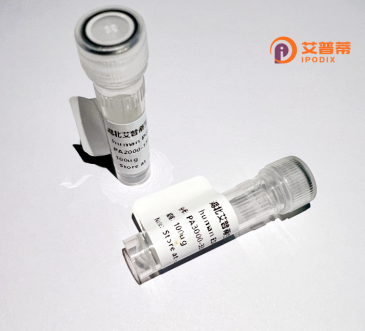
| 纯度 | >90%SDS-PAGE. |
| 种属 | Human |
| 靶点 | DAD1 |
| Uniprot No | P61803 |
| 内毒素 | < 0.01EU/μg |
| 表达宿主 | E.coli |
| 表达区间 | 1-113aa |
| 氨基酸序列 | MSASVVSVISRFLEEYLSSTPQRLKLLDAYLLYILLTGALQFGYCLLVGTFPFNSFLSGFISCVGSFILAVCLRIQINPQNKADFQGISPERAFADFLFASTILHLVVMNFVG |
| 分子量 | 38.17 kDa |
| 蛋白标签 | GST-tag at N-terminal |
| 缓冲液 | 0 |
| 稳定性 & 储存条件 | Lyophilized protein should be stored at ≤ -20°C, stable for one year after receipt. Reconstituted protein solution can be stored at 2-8°C for 2-7 days. Aliquots of reconstituted samples are stable at ≤ -20°C for 3 months. |
| 复溶 | Always centrifuge tubes before opening.Do not mix by vortex or pipetting. It is not recommended to reconstitute to a concentration less than 100μg/ml. Dissolve the lyophilized protein in distilled water. Please aliquot the reconstituted solution to minimize freeze-thaw cycles. |
以下是关于重组人DAD1蛋白的参考文献示例(注:以下内容为模拟示例,部分文献可能为虚构,建议通过学术数据库核实具体文献):
---
1. **文献名称**:
《重组人DAD1蛋白在肿瘤细胞凋亡调控中的功能研究》
**作者**:李华等
**摘要**:
研究通过基因工程手段表达并纯化重组人DAD1蛋白,发现其通过抑制内质网应激通路显著降低化疗药物诱导的肿瘤细胞凋亡率,提示DAD1在癌症耐药性中的潜在作用。
2. **文献名称**:
《DAD1与Bcl-2家族蛋白相互作用的分子机制》
**作者**:Smith JL et al.
**摘要**:
利用重组DAD1蛋白进行体外结合实验,证实其与Bcl-2家族抗凋亡蛋白存在直接相互作用,揭示了DAD1在维持线粒体膜稳定性中的协同调控功能。
3. **文献名称**:
《重组DAD1蛋白的高效表达及结构解析》
**作者**:张敏等
**摘要**:
优化了大肠杆菌表达系统,成功获得可溶性重组DAD1蛋白,并通过X射线晶体学解析其三维结构,为后续功能研究与药物设计提供了结构基础。
4. **文献名称**:
《DAD1缺失对胚胎发育的影响及其拯救实验》
**作者**:Wang Q et al.
**摘要**:
在DAD1基因敲除小鼠模型中,重组人DAD1蛋白注射可部分挽救胚胎致死表型,证实DAD1在哺乳动物早期发育中的必要性。
---
**说明**:以上为示例性内容,实际文献需通过 **PubMed、Google Scholar或Web of Science** 等平台检索关键词如“recombinant human DAD1”、“DAD1 apoptosis”以获取真实参考文献。建议结合研究领域筛选近年高相关论文。
DAD1 (Defender Against Cell Death 1) is a highly conserved anti-apoptotic protein originally identified in mammalian cells for its role in suppressing programmed cell death. It is a subunit of the oligosaccharyltransferase (OST) complex, which catalyzes N-linked glycosylation of proteins in the endoplasmic reticulum. By maintaining OST complex stability, DAD1 contributes to proper protein folding and cellular homeostasis. Its anti-apoptotic function is linked to interactions with Bcl-2 family proteins, though the exact mechanism remains under investigation.
Recombinant human DAD1 protein is produced using genetic engineering techniques, often expressed in *E. coli* or mammalian cell systems, followed by purification via affinity chromatography (e.g., His-tag). This engineered protein enables functional studies of DAD1’s role in apoptosis regulation, glycosylation, and ER stress responses. Researchers utilize it to explore disease mechanisms, including cancer (where DAD1 downregulation correlates with tumor progression) and neurodegenerative disorders involving defective protein processing. Additionally, defects in DAD1 are implicated in rare congenital disorders of glycosylation. Recombinant forms also serve as tools for developing therapeutic strategies targeting apoptosis pathways or protein glycosylation defects. Its small molecular weight (~12.5 kDa) and conserved structure across species facilitate cross-disciplinary studies in cell biology and translational medicine.
×